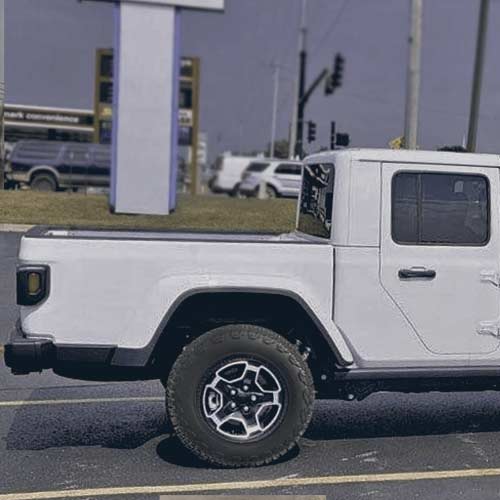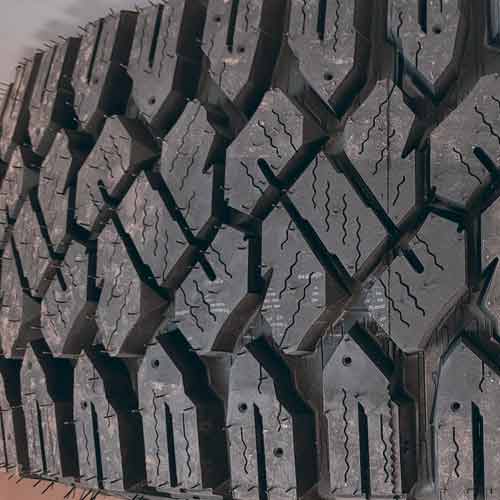The Yokohama Geolandar A/T XD brilliantly merges the ruggedness of mud terrain tires with the adaptability of all-terrain, allowing you to enjoy not only multiple terrain types, but also all kinds of weathers (which one can guess looking at its sidewalls having 3-peak mountain snowflake rating badge on it).
Let’s get in to details.

Table of Contents
Available Tire Sizes
The Geolandar A/T XD comes in 28 total sizes in 16 to 20 inches wheels, with following specs.
- Speed ratings: Q only.
- Load range: Only E available for now.
- Tread depth: 18 to 22/32″.
- Weight: 42 to 71 lbs.
- Treadwear warranty:
- Winter ratings: Both 3PMSF and M+S available (also offers studable lugs).
- Internal Construction: Depending on sizes, either 2 or 3 ply polyester (with high turn up), 2 steel belts and a single polyamide cap ply.
Tread Pattern
The Yokohama XD is masterfully designed with a robust and aggressive tread pattern, expertly tailored for a variety of terrains.

This tire features studable shoulder lugs, which significantly boost its performance on icy surfaces. Plus the edges of the tire are designed with in-groove notches that excel in providing deep snow traction, making it a reliable choice for winter conditions
Enhancing its off-road capabilities, the Geolandar XD is equipped with sharp, offset edges and scalloped outer edges. These features, along with strong sidewall lugs, contribute to outstanding performance on both dry terrain and rugged off-road conditions.
Furthermore, the tire is designed with wide circumferential grooves surrounding the central lugs, a feature that effectively resists hydroplaning and provide the tire with loose ground traction.
The central lugs are also very well engineered where the numerous off-sets, chamfered edges, notches and multi-directional siping provide consistent traction particularly in wet conditions, specifically enhancing tire’s wet braking capabilities.
So you see the tire’s tread speaks a lot about its overall capabilities across multiple scenarios.
Dry Performance
When evaluating dry performance, two key factors are paramount: the tire’s handling, including lateral traction and steering responsiveness, and its directional grip. Let me get into these performance aspects in detail.
Longitudinal Grip
Directional grip focuses on a tire’s traction during straight-line travel on dry roads, typically measured by braking distances and acceleration times.
The central tread section, which bears the majority of the vehicle’s weight during such travel, plays a critical role in road contact and overall grip.
Now here, the Geolandar AT XD does just okay. I mean there’s nothing special about its performance.
To give you an idea its average braking distance on 60 to 0 mph tests are very similar to Nitto Recon Grappler. BTW, you can review Nitto Recon Grappler here.
Lateral Grip and Handling
Handling is influenced by both lateral grip, which depends heavily on the design and contact quality of the tire’s shoulder ribs/sidewalls during cornering, and steering responsiveness.
Considering lateral grip, the shoulder area of the tire, which faces significant pressure during cornering, is critical for effective handling.
For example, the Yokohama Geolandar A/T XD, with its wide gaps between shoulder lugs, demonstrates lower lateral traction, evident from its reduced lateral g-forces compared to other rugged terrain tires.
Additionally, the Geolandar A/T XD shows slower lap times in handling tests, attributed to its lagging steering response. The steering feels dull at the center, requiring extra input to initiate direction changes, and often leads to oversteer once it responds.
This behavior is linked to the tire’s softer rubber composition and less reinforced structure compared to its competitors. With a tread depth of up to 22/32″, the lugs are prone to bending, which compromises contact with the road surface and affects traction and stability.
The delay in the lugs returning to their original shape translates into a lag between driver inputs and wheel feedback.
Off-Road Performance
Exploring off-road terrains brings its unique set of challenges, whether it’s maneuvering through thick mud or navigating across gravel and dirt paths.
Interestingly, some terrains are surprisingly manageable with tires designed primarily for on-road use. Let’s explore the characteristics of these varied landscapes in more detail.
Mud Traction
Effective mud traction demands that all-terrain tires possess a tread pattern designed for swift mud evacuation and efficient “paddling” through wet, sticky conditions.
Now our boy, the Yokohama Geolandar A/T XD excels in this environment with its wide longitudinal grooves and robust shoulder lugs, facilitating quick mud clearance.
The center biters slice through mud, while the innovative mini ridges within the grooves act as stone ejectors, breaking down particles for easier expulsion.
However, there is a slight drawback that the absence of staggered mud scoops on the shoulder lugs slightly reduces its traction compared to some more aggressively designed counterparts.
Rock Traction
Navigating rocky terrains requires a substantial contact patch, alongside features that enhance grip and durability. The Geolandar A/T XD meets these requirements with multidirectional biters that ensure grip from various angles.
Its 3-ply sidewalls equipped with GeoShield technology also enhance durability.
Nonetheless, the tire’s performance could transition from good to excellent with the addition of sidewall lugs, especially when the tire is aired down, enhancing its ability to navigate rocky landscapes more effectively.
Sand Traction
For optimal performance on sandy surfaces, reducing tire air pressure is crucial as it allows the tire to “float” more effectively over the soft terrain. The Geolandar A/T XD’s softer tread compound and lighter structure significantly aid this process.
The tire’s pliable lugs adapt well to sand, creating an extensive footprint that lessens the likelihood of becoming bogged down.
While its sidewalls may not be optimized for rocky terrains at lower pressures, they perform adequately on sand, offering a broad and effective contact patch that enhances traction on this challenging terrain.
In conclusion, the Geolandar A/T XD shows remarkable versatility across different off-road conditions, although some enhancements could further optimize its performance. For a comparison with another innovative model, check out the newly improved DuraTrac RT here.
Wet Performance
In wet conditions, the effectiveness of sipes which are of course small slits in the tire tread, plays a vital role.
To explain further, sipes function by trapping air. When compressed against the pavement, this air is expelled, creating a vacuum that draws in water, which is then dispersed as the tire rolls.
For optimal wet traction, tires must have plentiful, flexible sipes. The Yokohama Geolandar A/T XD excels in this area compared to other hybrid tires.
Despite its tough, cut-resistant rubber, it maintains flexible sipes thanks to several design features:
- The sipes are full-depth with a wave-like, interlocking 3D pattern, which prevents them from stiffening during aggressive maneuvers like cornering, braking, or accelerating.
- The sipes vary in angle across different ribs, enhancing wet traction in multiple directions and improving overall grip.
- The central lugs of the tire create a network of grooves that effectively disperse water, reducing the hydroplaning risk and alleviating the burden on the sipes, thereby enhancing traction.
Snow and Ice Performance
The Yokohama Geolandar A/T XD excels in winter conditions, handling a variety of terrains such as ice, deep snow, and plowed roads with aplomb. This tire is distinguished by its 3 Peak Mountain Snowflake (3PMSF) rating, signifying its superior winter capabilities.
It offers advanced snow-traction technology, enhancing grip through snow-to-snow contact which is more effective than rubber-on-snow interactions.
This is achieved through strategically placed in-groove notches and base tread biters that capture and retain snow particles, improving traction.
Additionally, the Geolandar A/T XD includes features like offset biting edges, shoulder notches, chamfered edges, and robust sipes in linear and wave patterns, which outperform previous models especially on icy surfaces.
The tire also supports optional studs for enhanced grip on compacted snow, providing exceptional traction.
It is noteworthy that tires with a 3PMSF rating typically perform 10% better in snow acceleration compared to all-season tires.
Wear Rate
The lifespan of the Yokohama Geolandar A/T XD’s tread is influenced by factors such as rolling resistance, tire composition, and tread depth. Although this tire features lighter weight and wider tread voids, these attributes place increased pressure on fewer lugs, accelerating wear due to greater friction against the road.
Additionally, the softer rubber composition makes the lugs prone to bending, which, as discussed in the dry handling section, generates heat and hastens wear.
Despite starting with a deep tread of 22/32″, the lack of reinforced lug foundations can adversely affect performance; excessive tread depth increases rolling resistance, reducing fuel economy and tread longevity.
Thus, while the initial deep tread suggests a longer wear life, the structural characteristics ultimately shorten the tire’s effective lifespan.
Ending Note
In conclusion, the Yokohama Geolandar A/T XD offers a robust performance across a spectrum of terrains, exhibiting strengths such as effective mud clearance, good rock traction, and superior wet handling due to its well-designed sipes and tread patterns.
Despite its versatility in off-road conditions and commendable winter performance marked by a 3PMSF rating, the tire’s dry performance and durability present some concerns.
The average braking distances and cornering grip fall short when compared to competitors, and its softer rubber composition may hasten wear, particularly under harsh conditions.
Enhancements in tread design and structural reinforcement could elevate its overall efficacy and lifespan, making it a more formidable contender in the rugged terrain tire market.